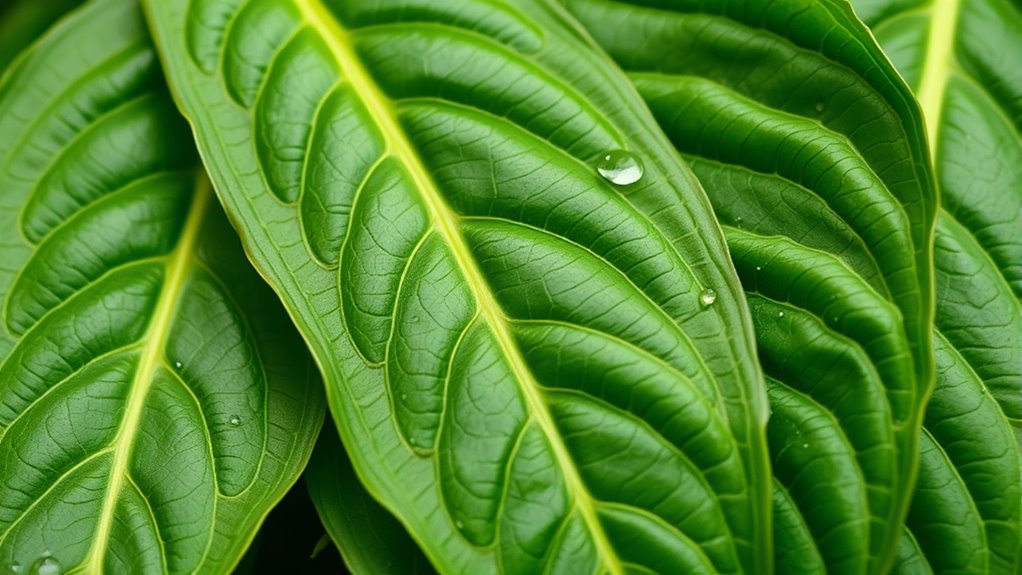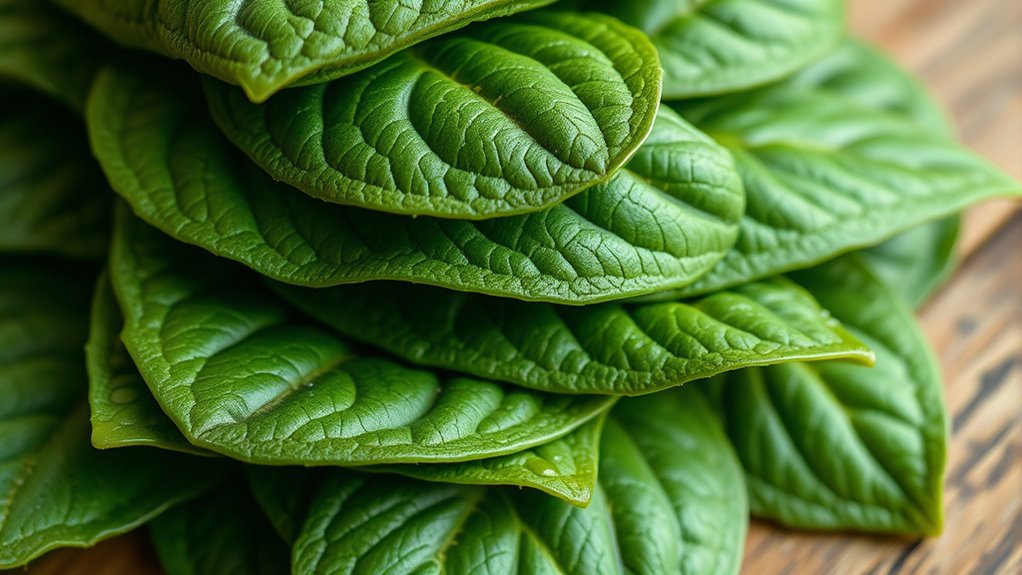Plantain leaf poultices are a natural, effective remedy backed by both tradition and science. You prepare them by crushing fresh leaves to release healing compounds like allantoin and aucubin, then applying them to skin irritations, bites, or wounds. These leaves help reduce inflammation, fight infection, and promote tissue healing thanks to their antimicrobial and anti-inflammatory properties. To discover how this simple remedy continues to support health naturally, keep exploring its proven benefits and scientific evidence.
Key Takeaways
- Plantain leaf poultices are rooted in traditional herbal remedies with scientific backing for their anti-inflammatory and antimicrobial properties.
- Preparation involves crushing fresh leaves to release healing compounds, then applying directly to skin irritations or wounds.
- They contain bioactive compounds like aucubin and allantoin that promote tissue regeneration and reduce inflammation.
- Modern studies confirm their effectiveness in soothing skin, preventing infection, and accelerating healing processes.
- This natural practice emphasizes health sovereignty, relying on plant-based remedies over chemical treatments.

Plantain leaf poultices are a natural remedy you can use to soothe skin irritations, insect bites, and minor wounds. These poultices harness the power of herbal healing, drawing on centuries of traditional remedies that have stood the test of time. When you turn to plantain leaves, you’re reconnecting with an age-old wisdom that champions simplicity and effectiveness. The plantain plant, often considered a common weed, holds potent medicinal properties that can dramatically ease discomfort and support your body’s natural healing processes. By embracing this herbal remedy, you’re choosing a path of liberation from chemical-laden treatments, reclaiming control over your health through nature’s offerings.
Plantain leaves offer a natural, effective remedy for skin irritations, insect bites, and minor wounds rooted in traditional herbal healing.
Using plantain leaves in poultice form is straightforward and empowering. You simply gather fresh leaves, crush or bruise them to release their healing juices, and apply them directly to your skin. The cool, moist leaf acts as a soothing barrier, reducing inflammation and preventing infection. Its anti-inflammatory and antimicrobial properties work synergistically to promote healing, helping minor wounds close faster and reducing pain from insect bites. This traditional remedy isn’t just effective; it’s accessible — no fancy equipment or pharmaceuticals needed. It’s about trusting your instincts and the natural world around you.
Herbal healing with plantain is backed by both anecdotal evidence and scientific research. Modern studies reveal that compounds in plantain leaves, such as aucubin and allantoin, have anti-inflammatory, soothing, and tissue-regenerating effects. These substances help calm irritated skin, diminish swelling, and accelerate tissue repair. When you incorporate plantain poultices into your self-care routine, you’re not only applying a time-honored remedy but also tapping into a natural pharmacy that has been used for generations across cultures. It’s about reclaiming your health sovereignty, asserting that Mother Nature’s pharmacy is enough to address many everyday ailments.
Traditional remedies like plantain poultices remind you that healing doesn’t need to be complicated or dependent on modern pharmaceuticals. Instead, it’s about harnessing the healing power of plants, understanding their potential, and trusting in nature’s wisdom. When you choose herbal healing, you’re making a statement: your body is capable of healing itself, given the right tools. Plantain leaves empower you to take that power back, providing a simple, effective means to treat minor skin issues naturally. By embracing this remedy, you stand for health freedom, connecting with a tradition rooted in respect for nature and self-reliance. Additionally, scientific research supports the use of plantain for skin healing due to its bioactive compounds which have anti-inflammatory and antimicrobial properties.
Frequently Asked Questions
How Long Can a Plantain Leaf Poultice Be Safely Applied?
You should apply a plantain leaf poultice for no more than 15 to 20 minutes at a time to guarantee application safety. Longer durations may cause skin irritation or discomfort. Trust your body’s signals, and if you notice redness or burning, remove the poultice immediately. Follow these duration guidelines to harness the healing power without risking adverse effects, empowering you to use plantain effectively and safely whenever needed.
Are There Any Known Allergic Reactions to Plantain Leaves?
You might experience allergic reactions or plantain sensitivity, though they’re rare. If you notice itching, redness, or swelling after using a plantain leaf poultice, stop immediately and wash the area. Everyone’s response varies, so stay alert to how your body reacts. By listening to your body’s signals, you can confidently harness plantain’s healing power while avoiding potential allergic reactions. Your health and freedom to choose are worth paying attention to.
Can Plantain Leaf Poultices Be Used on Open Wounds?
You can use plantain leaf poultices on open wounds, as research suggests its efficacy in promoting wound healing potential. This plant has anti-inflammatory and soothing properties that may help reduce infection and support tissue repair. Trust your instincts and give it a try—this natural remedy offers liberation from synthetic solutions. Just verify the leaves are clean, and monitor your wound for any signs of allergic reactions or irritation.
How Often Should a Poultice Be Changed During Use?
You should change the plantain leaf poultice every 1 to 2 hours during application to maintain freshness and effectiveness. This regular application frequency helps prevent skin irritation and ensures the poultice continues to draw out toxins or soothe the skin. Keep an eye on your skin; if you notice irritation or discomfort, increase the interval between changes or discontinue use to safeguard your skin’s health and feel empowered in your healing process.
Is There Scientific Evidence Supporting Plantain’s Antimicrobial Properties?
Imagine a hiker with a minor cut, applying a plantain poultice. Scientific research on plantain efficacy shows antimicrobial properties, supporting its traditional use. Antimicrobial research reveals compounds in plantain that inhibit bacteria, helping healing. You can trust this natural remedy to aid your body’s defense, offering you liberation from chemical medicines. The evidence is there—plantain’s antimicrobial properties are scientifically supported, making it a powerful, natural choice for wound care.
Conclusion
Now that you know how to prepare and use plantain leaf poultices, you can confidently harness nature’s healing power. Studies show that plantain leaves contain compounds that help reduce inflammation and fight infections—making them a natural remedy for skin issues. Remarkably, over 60% of people in traditional medicine communities worldwide rely on plantain leaves for wound care. So, next time you need a quick remedy, remember this versatile plant might just be your best ally.










